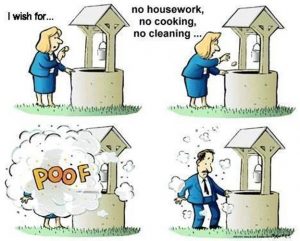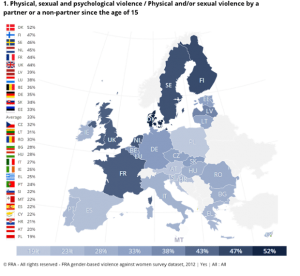The Nordic countries frequently rank high in various indexes about gender equality. Sweden, Denmark and Finland are considered as the most gender equal countries in the European Union. They look back at a long history of female public participation. Finland was the first country in the world to grant the vote to women in 1906. In the Human Development Report of the United Nations 2015 Norway is ranked as most equal country in the world. In 2012 between 70 and 80% of women in Nordic countries were employed. The EU average lay by 62,4 %.[1] Looking at this general numbers the Nordic countries seemed to have succeeded in generating equality between the sexes.
Yet, when analysing these statistics more in depth, one can easily see that there is something wrong. Though many women work in the Nordic countries, the number of women’s part time work is three times as high as of men. Furthermore, women often work in low paid sectors, like service or care. The gender pay gap lays by approx. 16% in the Nordic countries, the EU average. No greater gender equality. Due to part time work and lower salaries, women in the Nordic countries have a higher risk than men to become poor. Women also do the majority of house- and care work in the family.[2]

Still, what is even more concerning than that the Nordic countries might indeed just be average in economic terms of gender equality, is the fact that they rank incredible high in violence against women. The chance to experience sexual violence by a partner or a non-partner is for women in Sweden double as high as in the EU average. Domestic violence against women is nearly one third higher in Finland than in the EU average. Finland was also among the last countries to criminalize rape in marriage (1994). Only Denmark ranks here within the EU average. However, it was criticised in 2008 by Amnesty International for its lack of legal protection for victims of sexual violence.[3]

These numbers are alarming in many ways and show the bias of Nordic gender equality. Yes, women participated on the labour market. But often not voluntarily but by force. High living costs and the double breadwinner model make two earners in a family necessary. Further, women are usually only additional earner and randomly in high earning or power positions. If the primary earner disappears, the risk of poverty for Nordic women is high. They become customer of welfare measures.
Even more worrying is the violence against women. The Nordic states seem to do a lot to integrate women into the labour force and make them taxpayer but they fail to protect them at home. If I would be cynical, I would argue that economic and public interests dominate the striving of the Nordic countries for gender equality but there is less interest to protect women in the private sphere. Productivity appears somehow to be the driving force in Nordic gender policies and not general gender equality in the society. The new Finnish government, elected in 2015, for example decided to cut back in support for measures for gender equality, since men and women in Finland are apparently equal.
Well, are the Nordic countries a woman’s heaven or hell? Probably neither of it. Gender equality in the Nordic countries appears very much on the surface but a deeper look discovers many problems. Surely, Nordic women live a better life than a lot of their sisters in the entire world. And yes, also men experience inequalities. Inequalities appear not only through gender but also through race, class, disability and numerous categories. However, the lesson learned from this brief and rather incomplete discussion of gender equality in the Nordic countries is that labour market participation does not create equality between the sexes. To provide equality women need equal opportunities and not any opportunities in the public sphere. Furthermore, the state must also protect women in the private sphere. The high number of cases of violence against women in the Nordic countries are disgraceful for countries which claim to be the most gender equal in the world. Gender equality is not a pick and choose but comes as a package of all women in all areas being equal to all men, and here the Nordic countries surely still have a lot of catching up to do.
[1] Eurostat
[2] Nordic Gender Equality in Figures 2015, Nordic Council of Ministers
[3] http://eige.europa.eu/gender-statistics/gender-equality-index/2012/domain/violence/
[4] https://www.theguardian.com/news/datablog/2014/mar/05/violence-against-women-european-union-physical-sexual-abuse
MERLE WESSEL is a Doctoral student at the Centre for Nordic Studies (2014-) and she holds a doctoral position in the Doctoral Programme Political, Societal and Regional Change (2016-2019). Her doctoral project “Eugenic Feminism in the Nordic Countries” discusses how Nordic feminists used eugenic rhetoric to include or exclude women from civil and political rights, and to position the female body and sexuality in the societal discourse. Her main research interests are gender history, body and sexuality, and cultural history.
Women in New Zealand were granted the vote in 1893, more than a decade before Finland.
I replied last week correcting your assertion that women in Finland were the first in the world to become enfranchised. That comment is still awaiting moderation.
The women of Wyoming, just the one state in USA, got the vote a little before the women of NZ.
Women in UK had to wait until after WW1.
The rest of your writing loses credibility when you make such a simple error.